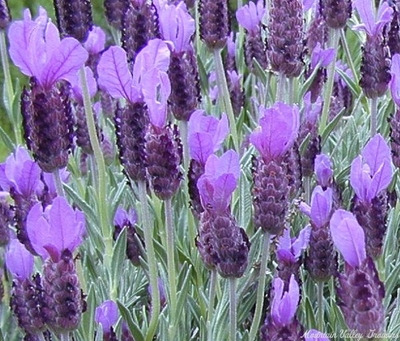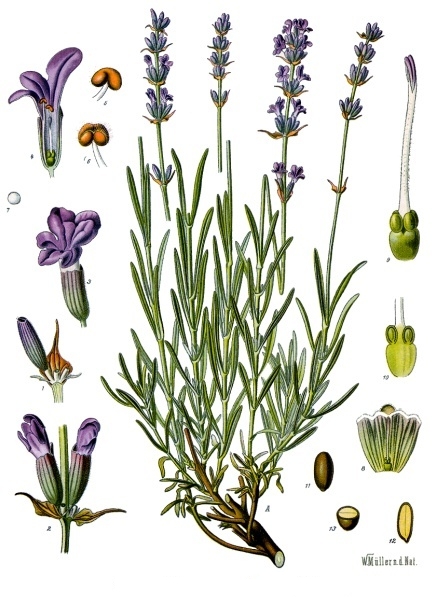 This is an update on my attempt to grow lavender in Mississippi. “Attempt” is the opperative word. While I was able to grow lavender in New Jersey, my attempts to do the same thing in Mississippi failed. Bottom line: It is too hot in Mississippi to grow lavender. According to Gary Bachman, Ornamental Horticulture Specialist for the Mississippi State University Extension Service, Spanish Lavender is best for Mississippi gardens, and I agree that my Spanish lavender survived a bit longer than my English lavender, but I will not attempt to grow any kind of lavender in the unrelenging, blistering heat that is part of living in the Deep South of the USA.
This is an update on my attempt to grow lavender in Mississippi. “Attempt” is the opperative word. While I was able to grow lavender in New Jersey, my attempts to do the same thing in Mississippi failed. Bottom line: It is too hot in Mississippi to grow lavender. According to Gary Bachman, Ornamental Horticulture Specialist for the Mississippi State University Extension Service, Spanish Lavender is best for Mississippi gardens, and I agree that my Spanish lavender survived a bit longer than my English lavender, but I will not attempt to grow any kind of lavender in the unrelenging, blistering heat that is part of living in the Deep South of the USA.
“Spanish lavender grows two feet tall and wide and has fat purple flower buds with spiral petals. The other lavenders—Lavendon, English, and French—don’t like our high humidity. … Modification of the soil environment is required, and soil drainage is a must. This is where using raised beds are a good choice. Amend the soil with grip, pea gravel, or oyster shells to make the soil gravelly. Oyster shells will help to keep the soil alkaline and help your lavender thrive. …
“Harvest the fresh cut flowers just as the buds start to open. For dried lavender, cut just before the first flowers open and bundle twenty stems per bundle. Hang upside down out of the sun with plenty of air circulation.” Bachman
Bachman, Gary. “Lavender.”MISSISSIPPI STATE UNIVERSITY EXTENSION, 12 Oct. 2018, extension.msstate.edu/southern-gardening/audio/2018/lavender-0. Accessed 2 July 2023.

Spanish Lavender – Image Credit: Mountain Valley Growers
“Spanish Lavender blooms profusely in the spring and when it finishes it needs a good pruning. The result will be an attractive, fragrant, gray-green shrub throughout the rest of the year.” Native to the Mediterranean region and North Africa, Spanish Lavender seems to be a more suitable lavender choice for those who garden in hot humid climates. The antiseptic, piney fragrance of Spanish Lavender makes it an exceptionally fragrant landscape plant but not the first choice for use in cooking. English Lavenders, both Lavandula angustifolias and Lavandula x intermedias, are preferred in the kitchen.
“Spanish Lavender is probably what the ancient Greeks and Romans used to scent their bath water. Indeed the word Lavender is from Latin lavare (to wash). Spanish Lavender is often referred to in older publications as French Lavender (which, today, is how we refer to L. dentata).” Mountain Valley Growers https://mountainvalleygrowers.com/organic-plants/lavandula-stoechas-spanish-lavender/
Propagating Spanish Lavender
“Propagating Spanish lavender through cuttings is easy and rewarding. You will need a pair of sharp garden snips, a small pot, well-draining soil, a plastic bag, and a rubber band. Then follow these instructions:
“Take cuttings in the spring or fall. Snip where the new growth meets the old and aim to remove a cutting with no flowers.
Remove all the leaves on the lower half of the cutting.
Gently plant the stripped end into well-draining dirt. Keep the soil level to just below where the leaves start.
Place the plastic bag over the cutting to keep in moisture. Secure it around the pot with a rubber band.
Keep the soil moist until the plant is established. Check for roots by gently tugging on the cutting. When there is resistance, roots have formed. Remove the plastic bag once this occurs.
Alternatively, you can place your cuttings in a glass of water until roots appear. Be sure the water does not soak the leaves. Once healthy roots form, plant the cutting in soil.
How to Grow Spanish Lavender From Seed
“Spanish lavender can also be grown from seed. Here is how to do it:
“Spanish lavender seeds have the best outcome when started indoors. Sow the seeds into well-draining soil in small pots and cover them lightly.
Keep the seeds in a cool place. Regularly check the soil, making sure to keep it moist.
Germination should occur in about 2 weeks.
Keep the seedlings in a sunny location.
When seedlings are big enough to handle, transfer them to their own pots or plant in the garden in the spring.
Potting and Repotting Spanish Lavender
“Spanish lavender grows very well in containers. When choosing a container, be sure it has multiple drainage holes and drains water freely. Because a potted plant does not have access to underground water sources, potted lavender will need to be watered more often than lavender planted in the garden. Water deeply and infrequently when the soil feels dry. These plants often need to be repotted yearly. To do this, gently tip the pot onto its side and tap around the outside of the pot. This will loosen the root system. Gently slide the lavender out and place it in its new pot. Fill the pot with sandy, well-draining soil and place it in a sunny location.
Overwintering Spanish Lavender
“When grown in its appropriate growing zones, Spanish lavender does not require much extra attention to survive the winter. Simply add an extra layer of mulch around the plant to help insulate the root system. Cut back on watering and only water if the winter is exceptionally dry. For potted lavender, move it to a sheltered area away from harsh temperatures or winds.
How to Get Spanish Lavender to Bloom
“Spanish lavender is known for its unique blooms, often described as purple pineapples or as having rabbit ears. They have a beautiful lavender aroma and may appear in two large flushes of blooms each year. Spanish lavender begins to bloom in the spring and continues throughout the summer.
“To encourage blooming, plant Spanish lavender in full sunshine. Deadhead spent blooms throughout the year and prune twice a year. The first pruning should be done after the first flush of blooms. Remove about one-third of that year’s growth to encourage a second flush of blooms. Then repeat the process to prepare the plant for fall.
Common Problems With Spanish Lavender
“Spanish lavender is rather hardy and does not often struggle with pests or other problems. However, foliage problems can be caused by subpar soil or moisture conditions.
Yellowing, Browning, Drooping Leaves
“This can be a sign of root rot. Because Spanish lavender needs well-draining soil and minimal moisture, it is susceptible to developing root rot in overly wet conditions. If you suspect that a plant has root rot, cut back on watering. Remove any organic material, such as fallen leaves, around the plant. Then gently dig up the plant to inspect the roots. Remove any rotting roots with a clean pair of snips, then plant the lavender in an area with well-draining soil and full sunshine. Be sure to give the plant adequate airflow.
Leggy, Yellow Foliage, and Few Flowers
“This is a sign of too much nitrogen and is often caused by giving the plant too much fertilizer. If this is the case, stop fertilizing. Then remove the lavender from the rich soil. Either amend the soil with sand and gravel or move the lavender to a pot. Prune around one-third of the leggy growth in the spring or fall to help the lavender regain its compact shape.” The Spruce

English Lavender
Lavandula augustifolia|
Height: 1′ – 3′
Image Credit: Gardenia.net

Image Credit: Wikipedia
Discover more from Jacki Kellum
Subscribe to get the latest posts sent to your email.